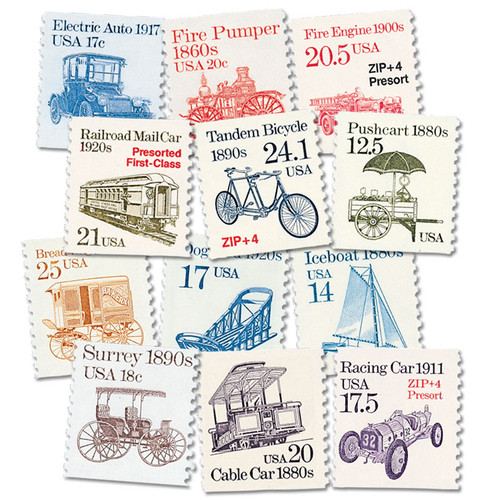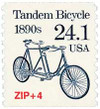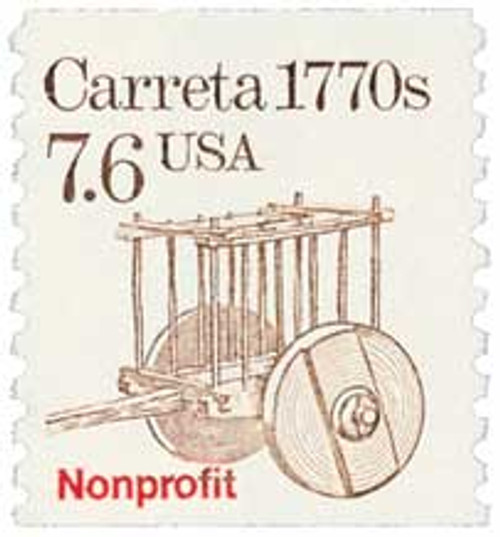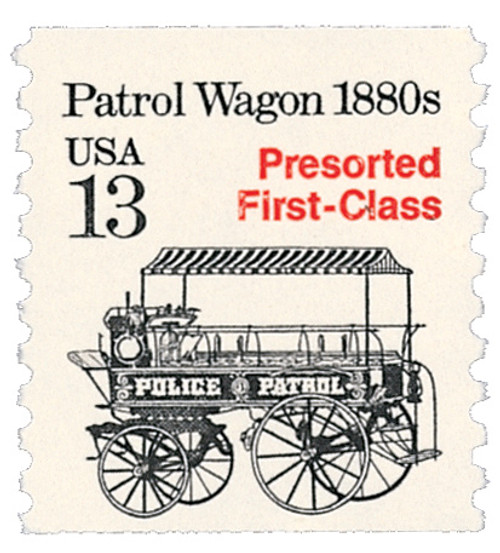
# 2266 - 1988 24.1c Transportation Series: Tandem Bicycle, 1890s
U.S. #2266
1988 24.1¢ Tandem Bicycle, 1890s
Transportation Series
- Issued in “The Bicycle Capital of the Northwest”
- 2nd stamp in Transportation Series featuring a bicycle
Stamp Category: Definitive
Series: Transportation
Value: 24.1¢, ZIP+4 unsorted rate
First Day of Issue: October 26, 1988
First Day City: Redmond, Washington
Quantity Issued: 65,125,000
Printed by: Bureau of Engraving and Printing
Printing Method: Engraved
Format: Coils of 500 and 3,000
Perforations: 10 vertical
Color: Deep ultra
Why the stamp was issued: This stamp replaced the 1985 21.1¢ Sealed Envelopes stamp paying the ZIP+4 rate. The USPS said the tandem bicycle was “symbolic of ‘work-sharing’” and there “an appropriate image for ZIP+4, which facilitates an automated sort down to small sectors in the delivery sequence.”
About the stamp design: Christopher Calle provided the illustration for this stamp, based on a photo from the Smithsonian of a Columbia Model No. 43 tandem bicycle. The bicycle was built by the Pope Manufacturing Company of Hartford, Connecticut, in 1896.
Special design details: This stamp has a “ZIP+4” precancel. Precancels are stamps canceled before being sold, to make mailing faster and cheaper for customers with large amounts of mail. Bulk mailers use precancels, then pre-sort their mail and save money.
First Day City: The First Day ceremony for this stamp was held at the Sahalee Country Club in Redmond, Washington. Redmond claims to be “The Bicycle Capital of the Northwest.”
About the Transportation Series: On May 18, 1981, the USPS issued the first stamp in the Transportation Series, US #1907, picturing the Surrey, a doorless four-wheeled carriage. For the first time in US history, a coil stamp featured its own unique design rather than simply copying that of the current definitive stamp. Over 50 more coil stamps would be issued over the course of the next 15 years, each picturing a different mode of transportation. All of these types of transportation were used since American independence.
The various denominations provided face values to exactly match the rates for several categories of Third-Class mail (bulk rate and quantity-discounted mail). As the rates changed, new stamps with new values were added. Never before had a stamp series included so many fractional cent values.
The Bureau of Engraving and Printing printed most of the stamps in the Transportation Series, although private contractors printed a few. All but a few of the later stamps were produced by engraved intaglio. Differences in precancels, tagging, paper and gum provide a large number of varieties.
Scott Catalog separates the Transportation stamps into four groups. The stamps in the first group (#1897-1908) generally have the denomination in small type with a “c” next to it. These stamps were printed on the Cottrell rotary press, which joined together two plates to make a sleeve. The gaps between these plates created depressions where ink would collect and create joint lines on the stamps. Later issues were printed on a different press and didn’t have these joint lines.
The second group (#2123-36) had larger numbers with no “c.” The third group (#2252-66) was similar in appearance to the second group, but service inscriptions were added to the designs. These stamps also used a variety of paper and gum as well as different types of tagging. The fourth group (#2451-68) marked the end of fractional values. Now bulk mailers would use either the 5¢ or 10¢ stamp and then pay the difference from the actual postage rate.
The last stamp in the Transportation Series, the 20¢ Cog Railway, was issued on June 9, 1995, at the TEXPEX ’95 stamp show in Dallas, Texas. This marked the end of the largest US definitive series up to that time. Three new series would eventually replace it – American Transportation, American Culture, and American Scenes. Additionally, the Great Americans would go on to become the largest American definitive series.
History the stamp represents: Known as the "bicycle built for two," the tandem bicycle requires both partners to coordinate their efforts and goals. A familiar sight around the turn of the century, its popularity declined when the nation's interest turned to automobiles. Today, their rare appearance causes observers to do a double-take.
U.S. #2266
1988 24.1¢ Tandem Bicycle, 1890s
Transportation Series
- Issued in “The Bicycle Capital of the Northwest”
- 2nd stamp in Transportation Series featuring a bicycle
Stamp Category: Definitive
Series: Transportation
Value: 24.1¢, ZIP+4 unsorted rate
First Day of Issue: October 26, 1988
First Day City: Redmond, Washington
Quantity Issued: 65,125,000
Printed by: Bureau of Engraving and Printing
Printing Method: Engraved
Format: Coils of 500 and 3,000
Perforations: 10 vertical
Color: Deep ultra
Why the stamp was issued: This stamp replaced the 1985 21.1¢ Sealed Envelopes stamp paying the ZIP+4 rate. The USPS said the tandem bicycle was “symbolic of ‘work-sharing’” and there “an appropriate image for ZIP+4, which facilitates an automated sort down to small sectors in the delivery sequence.”
About the stamp design: Christopher Calle provided the illustration for this stamp, based on a photo from the Smithsonian of a Columbia Model No. 43 tandem bicycle. The bicycle was built by the Pope Manufacturing Company of Hartford, Connecticut, in 1896.
Special design details: This stamp has a “ZIP+4” precancel. Precancels are stamps canceled before being sold, to make mailing faster and cheaper for customers with large amounts of mail. Bulk mailers use precancels, then pre-sort their mail and save money.
First Day City: The First Day ceremony for this stamp was held at the Sahalee Country Club in Redmond, Washington. Redmond claims to be “The Bicycle Capital of the Northwest.”
About the Transportation Series: On May 18, 1981, the USPS issued the first stamp in the Transportation Series, US #1907, picturing the Surrey, a doorless four-wheeled carriage. For the first time in US history, a coil stamp featured its own unique design rather than simply copying that of the current definitive stamp. Over 50 more coil stamps would be issued over the course of the next 15 years, each picturing a different mode of transportation. All of these types of transportation were used since American independence.
The various denominations provided face values to exactly match the rates for several categories of Third-Class mail (bulk rate and quantity-discounted mail). As the rates changed, new stamps with new values were added. Never before had a stamp series included so many fractional cent values.
The Bureau of Engraving and Printing printed most of the stamps in the Transportation Series, although private contractors printed a few. All but a few of the later stamps were produced by engraved intaglio. Differences in precancels, tagging, paper and gum provide a large number of varieties.
Scott Catalog separates the Transportation stamps into four groups. The stamps in the first group (#1897-1908) generally have the denomination in small type with a “c” next to it. These stamps were printed on the Cottrell rotary press, which joined together two plates to make a sleeve. The gaps between these plates created depressions where ink would collect and create joint lines on the stamps. Later issues were printed on a different press and didn’t have these joint lines.
The second group (#2123-36) had larger numbers with no “c.” The third group (#2252-66) was similar in appearance to the second group, but service inscriptions were added to the designs. These stamps also used a variety of paper and gum as well as different types of tagging. The fourth group (#2451-68) marked the end of fractional values. Now bulk mailers would use either the 5¢ or 10¢ stamp and then pay the difference from the actual postage rate.
The last stamp in the Transportation Series, the 20¢ Cog Railway, was issued on June 9, 1995, at the TEXPEX ’95 stamp show in Dallas, Texas. This marked the end of the largest US definitive series up to that time. Three new series would eventually replace it – American Transportation, American Culture, and American Scenes. Additionally, the Great Americans would go on to become the largest American definitive series.
History the stamp represents: Known as the "bicycle built for two," the tandem bicycle requires both partners to coordinate their efforts and goals. A familiar sight around the turn of the century, its popularity declined when the nation's interest turned to automobiles. Today, their rare appearance causes observers to do a double-take.





















